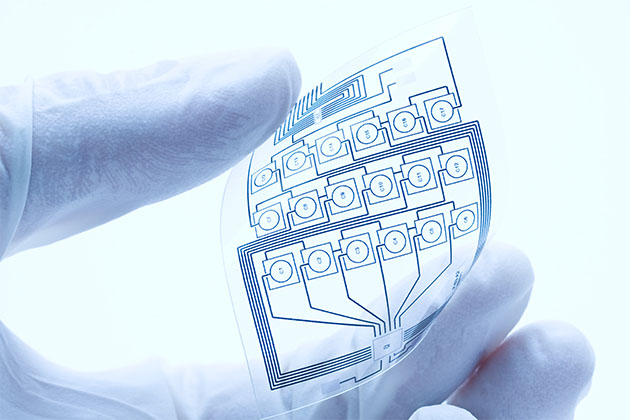مهندسان نیمه هادی ساخته شده از یک ماده هیبریدی انعطاف پذیر نازک را اختراع کرده اند که می تواند در آینده نزدیک برای نمایشگرهای دستگاه های الکترونیکی استفاده شود.
مهندسان شرکت های بزرگ به دنبال طراحی صفحه نمایش تاشو و انعطاف پذیر برای الکترونیک بوده اند دستگاه like computers and mobile phones. The goal is a display screen which would feel like a paper i.e. be bendable but also function electronically. Samsung, one of the largest mobile phone manufacturers in the world will in all probability be launching a flexible mobile phone very soon. They have developed a flexible سازمانی light emitting diode (OLED) panel which has an unbreakable surface. It is lightweight but tough and robust and can withstand high temperatures. Its most remarkable feature would be that this display will not break or be damaged if the device falls – the biggest challenge faced today by mobile phone display designers. A regular LCD screen continues to display even when bent but the liquid inside it becomes misaligned and hence a distorted image is displayed. The new flexible OLED screen could be bent or curved without distorting the display, however, it still won’t be completely foldable. The flexibility can be further increased by using more flexible nanowires in the future. A quantum dot light emitting diode display is more flexible because of the use of nano-crystals to produce high-quality sharp light. The displays still have to be encapsulated into glass or other material for protection.
یک ماده جدید برای ساخت صفحه نمایش های انعطاف پذیر
در مطالعه اخیر منتشر شده در مواد پیشرفته engineers from The Australian National University (ANU) have for the first time developed a semiconductor made from سازمانی and inorganic material which efficiently converts electricity into light. This semiconductor is ultra-thin and very flexible making it unique. The سازمانی part of the device, an important part of the semiconductor has a thickness of only one atom. The inorganic part is also small, about two atoms thick. The material was constructed by a process called ‘chemical vapor deposition’, similar to building a 3-dimensional structure from a 2D description. The semiconductor cannot be seen with naked eye, it rests between gold electrodes on a chip of size 1cm x 1cm having a functional transistor. One such chip can hold thousands of transistor circuits. The electrode serves as electricity input and output point. Once constructed opto-electronic and electrical properties of the material were characterized. This hybrid structure of سازمانی and inorganic components converts electricity into light which then provides display on mobile phones, televisions and other devices. The light emission is seen to be sharper and better for higher-resolution displays.
چنین ماده ای را می توان در آینده نزدیک برای خم شدن دستگاه ها استفاده کرد - مثلاً تلفن های همراه. آسیب دیدن صفحه نمایش یا صفحه نمایش در تلفن های همراه بسیار رایج است و این مواد می توانند به کمک بیایند. با افزایش محبوبیت و تقاضای تلفنهای هوشمند با صفحه نمایش بزرگتر، نیاز روز این است که دوام داشته باشند به طوری که صفحه نمایش مستعد خراشیدگی یا شکستگی یا افتادن و غیره نباشد. ساختار هیبریدی از نظر کارایی نسبت به نیمهرساناهای سنتی که تماما از سیلیکون ساخته شده است. از این ماده می توان برای ساخت صفحه نمایش برای تلفن های همراه، تلویزیون، کنسول های دیجیتال و غیره استفاده کرد و شاید یک روز کامپیوتر بسازد و یا یک تلفن همراه را به استحکام یک ابر کامپیوتر بسازد. محققان در حال حاضر روی تولید این نیمه هادی در مقیاس بزرگتر کار می کنند تا بتوان آن را تجاری کرد.
مقابله با زباله های الکترونیکی
It is estimated that 2018 will be produce a total of almost 50 million tons of electronic waste (e-waste) and very limited quantity would be recycled. E-waste constitutes electronic devices and equipment which have reached the end of their life and need to be discarded including old computers, office or entertainment electronic equipment, mobile phones, television etc. Massive amount of e-waste is a huge threat to the environment and is bound to cause irreversible damage to our natural resources and surroundings. This discovery is a starting point for designing electronic devices exhibiting high performance but which are made from سازمانی ‘bio’ materials. If mobile phones were made of a flexible material they would be easier to recycle. This will cut down on e-waste generated annually across the globe.
آینده دستگاه های الکترونیکی تاشو و انعطاف پذیر بسیار هیجان انگیز خواهد بود. مهندسان در حال حاضر به نمایشگرهای قابل چرخش فکر می کنند که دستگاه ها را می توان مانند یک اسکرول جمع کرد. پیشرفته ترین نوع صفحه نمایشی است که می تواند مانند کاغذ تا شود، منحنی شود یا حتی خرد شود، اما می تواند به نمایش تصاویر منظم ادامه دهد. زمینه دیگر استفاده از مواد "آکستتیک" است که با کشیده شدن ضخیم تر می شوند و می توانند تاثیرات انرژی بالا را جذب کرده و برای اصلاح هر گونه اعوجاجی خود را تغییر دهند. چنین دستگاه هایی سبک وزن و در عین حال انعطاف پذیر خواهند بود.
***
{شما میتوانید مقاله پژوهشی اصلی را با کلیک بر روی پیوند DOI که در فهرست منابع ذکر شده در زیر آمده است بخوانید}
منبع (ها)
شارما آ و همکاران 2018. پمپاژ اکسایتون کارآمد و وابسته به لایه در ساختارهای ناهمسان آلی-غیر آلی از نظر اتمی نازک نوع I. مواد پیشرفته. 30 (40).
https://doi.org/10.1002/adma.201803986
***






































